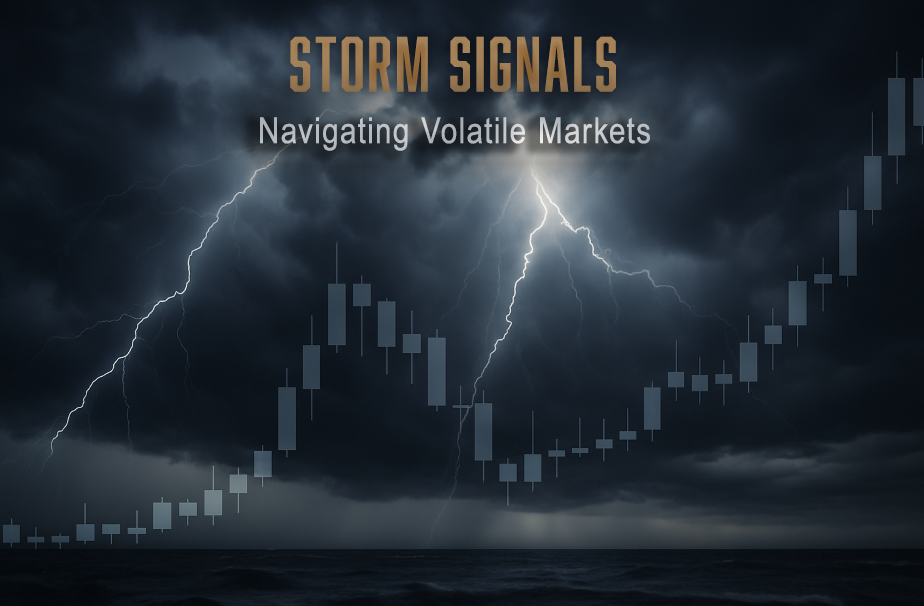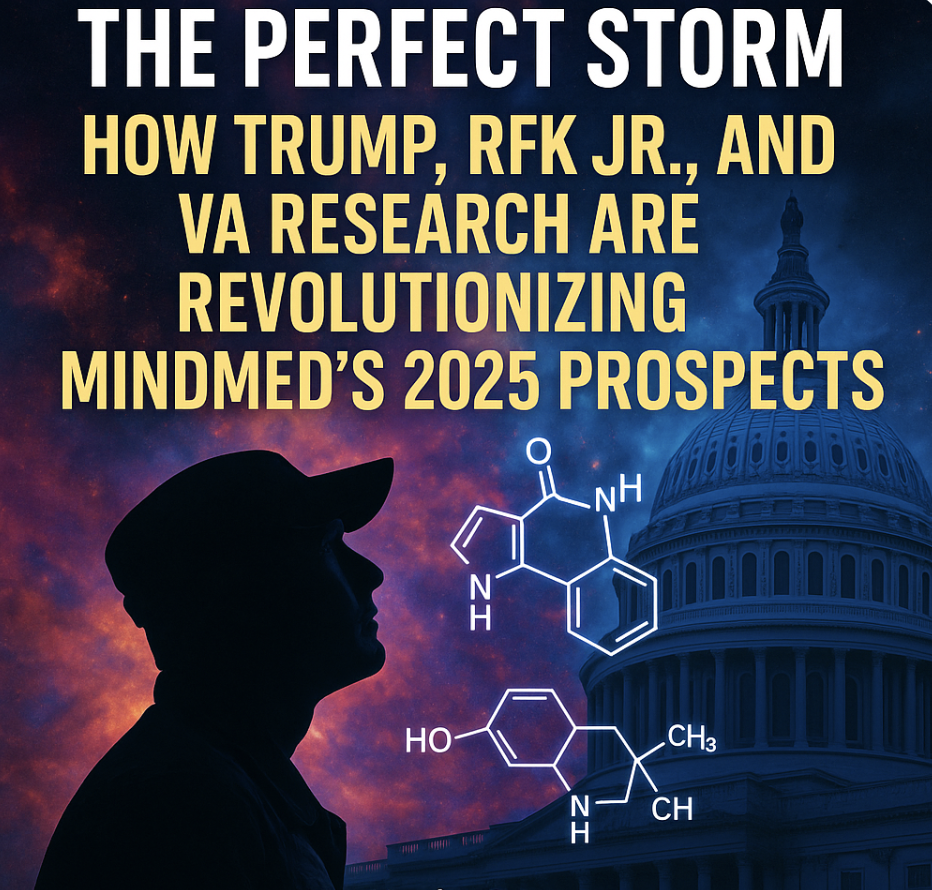The Perfect Storm: How Trump, RFK Jr., and VA Research Are Revolutionizing MindMed’s 2025 Prospects
The Perfect Storm: How Trump, RFK Jr., and VA Research Are Revolutionizing MindMed’s 2025 Prospects

Richard Nixon is probably rolling over in his grave right now, as his war on drugs has evolved into war veterans taking drugs. Following the Fourth Turning Theory (link to other blog), we are in a crucial period of awakening and change, and one of those changes has been an increasing rise of microdosing and de-stigmatizing psychedelic drugs.
In what can only be described as a watershed moment for psychedelic medicine, the Department of Veterans Affairs has announced its first federally-funded study of MDMA-assisted therapy since the 1960s—a $1.5 million research initiative targeting the devastating dual epidemics of PTSD and alcohol use disorder among America’s veterans.
This development represents far more than just another clinical trial; it signals a fundamental paradigm shift in how our government approaches mental health treatment for those who have served our country. Against this transformative backdrop, MindMed (MNMD) stands at a critical inflection point, offering opportunities for increased mental health for veterans and financial health for traders. In this article, I’ll examine how this perfect storm of political, scientific, and market forces could fundamentally reshape MindMed’s trajectory in 2025 and beyond, providing investors with a comprehensive framework for what could become one of the most significant paradigm shifts in psychiatric treatment this century.
The Political Paradigm Shift for Psychedelic Medicine
MindMed has strategically positioned itself in the psychedelic medicine landscape with a diversified clinical pipeline that includes its addiction-focused 18-MC program, LSD microdosing studies for PTSD, and MM-120 program complementing MDMA research. The company distinguishes itself from competitors like COMPASS Pathways and ATAI Life Sciences through its unique intellectual property portfolio, specialized management expertise, and sufficient financial runway through 2026. Growth opportunities include potential VA collaborations amid bipartisan support for veteran mental health initiatives, expanding academic partnerships, developing specialized veteran care clinics, and leveraging regulatory advantages in international markets like Canada and Europe.
With its diversified clinical pipeline, including proprietary compounds like 18-MC for addiction disorders and advanced-stage trials of LSD microdosing for anxiety and depression, the company is poised to capitalize on this rapidly evolving landscape. What makes this moment particularly compelling for investors is the unprecedented convergence of seemingly disparate forces:
Trump expanding on Biden’s research:
Something no one had on their bingo card, Trump is following through and even extending on Biden’s psychedelic research initiatives. This decision appears driven by political calculations around veteran mental health support, with the administration’s pro-military stance providing adequate political cover for advancing psychedelic research.
RFK Jr.’s appointment as Secretary of Health and Human Services:
His new leadership role represents a transformative influence on psychedelic medicine policy. His background includes long-standing advocacy for medical freedom and alternative treatments, with specific positions supporting psychedelic research.
Bipartisan support:
The phenomenon of bipartisan support has created unusual political alignment around psychedelic medicine. Congressional backing crosses traditional party lines, primarily driven by influential veteran advocacy groups that have maintained consistent policy momentum. Public opinion regarding psychedelic therapies for veterans has shifted remarkably, creating a uniquely protected research environment that transcends typical political divisions.
Financial Implications for MindMed Investors
MindMed investors face potential valuation recalibration as historical metrics for breakthrough psychiatric treatments suggest a significant upside compared to traditional pharmaceutical timelines. The veteran-focused market alone represents a substantial population, while broader commercial applications could expand this opportunity exponentially. The institutional investment landscape shows evolving dynamics, with current moderate institutional ownership creating headroom for expanded adoption as several prominent healthcare-focused funds begin showing active interest in the psychedelic medicine sector. However, activists remain watchful of governance practices.
Looking ahead to 2025-2026, the company’s capital markets strategy includes multiple financing pathways that balance dilution concerns with strategic goals, while potential uplisting opportunities could dramatically improve liquidity and visibility, complemented by anticipated analyst coverage expansion from specialized healthcare boutiques to larger investment banks as clinical milestones are achieved, all while management navigates critical share structure decisions that will impact long-term investor returns.
Timeline of Potential Catalysts Through 2025-2026

MindMed faces multiple catalysts through 2025-2026, beginning with regulatory milestones including crucial FDA interactions in mid-2025, DEA scheduling review processes expected by early 2026, parallel regulatory developments in Canada and Europe that could provide strategic optionality, and progressive state-level frameworks creating regional opportunities even before federal approval. The clinical development pathway features several pivotal trial readouts, with Phase 2b data for MM-120 expected in Q3 2025, acceleration in patient enrollment following veterans’ advocacy support, high-profile data presentations scheduled at major psychiatric conferences, and potential breakthrough therapy designations that could compress development timelines.
Government policy developments add further momentum, with VA policy updates anticipated following initial research results, preliminary Medicare/Medicaid coverage discussions beginning as early as late 2025, advanced planning for military healthcare system integration specifically targeting veteran populations, and federal budget allocations for 2026 potentially including dedicated funding for psychedelic medicine research and implementation programs.
Risk Assessment and Mitigation Factors
MindMed faces several clinical development uncertainties that investors should monitor, including potential safety concerns specific to psychedelic therapies, such as psychological adverse events. From manufacturing challenges in scaling production of pharmaceutical-grade psychedelics to limitations in healthcare delivery systems unprepared for psychedelic-assisted therapy protocols, concerns can vary. The political landscape remains volatile despite current bipartisan support, with upcoming mid-term elections potentially shifting priorities, congressional budget challenges threatening research funding, and public opinion susceptible to negative media coverage.
Competitive threats include potential Big Pharma entry as the sector gains legitimacy, emerging competitors developing non-psychedelic alternatives targeting similar indications, ongoing patent protection challenges for naturally-derived compounds, and complex pricing and reimbursement considerations that could limit commercial potential.
Investment Strategy Considerations
For investors considering MindMed, thoughtful position sizing within broader biotech/healthcare exposure is essential, with allocation reflecting both the high-risk/high-reward profile of psychedelic medicine and individual risk tolerance. At the same time, maintaining time horizon alignment with the extended development timelines typical in this sector and potentially diversifying across multiple psychedelic medicine companies to mitigate company-specific risks are also important. Technical analysis reveals essential factors, including key support/resistance levels that have historically defined trading ranges, distinctive volume patterns during major clinical or regulatory announcements, and short interest trends.
Optimal entry point strategies include a milestone-based investment approach that increases positions following achievement of predefined clinical or regulatory events rather than speculative catalysts, complemented by dollar-cost averaging considerations to build positions systematically through the inevitable volatility of early-stage biotech development. Investors should also develop systems for news-driven opportunity identification to capitalize on disconnects between developments and market reactions, while implementing volatility management techniques such as predetermined stop-loss levels to protect capital during sector fluctuations.
The emerging psychedelic medicine sector represents a unique investment opportunity created by an unprecedented confluence of political support, scientific validation, and societal need, particularly as veteran mental health concerns drive regulatory innovation. This moment marks a potentially historic inflection point for psychiatric medicine, comparable to the introduction of SSRIs but with potentially more transformative implications for treatment-resistant conditions. While the opportunity for early investors in well-positioned companies like MindMed appears substantial, the inherently speculative nature of pre-revenue biotech investments demands disciplined risk management and realistic expectations regarding timeline uncertainties. Investors should closely monitor key developments throughout 2025, particularly focusing on clinical trial results, regulatory interactions, and shifts in the political landscape that could accelerate or impede the sector’s evolution. To learn more about navigating market changes like MNMD, join us at Trade Ideas today.
